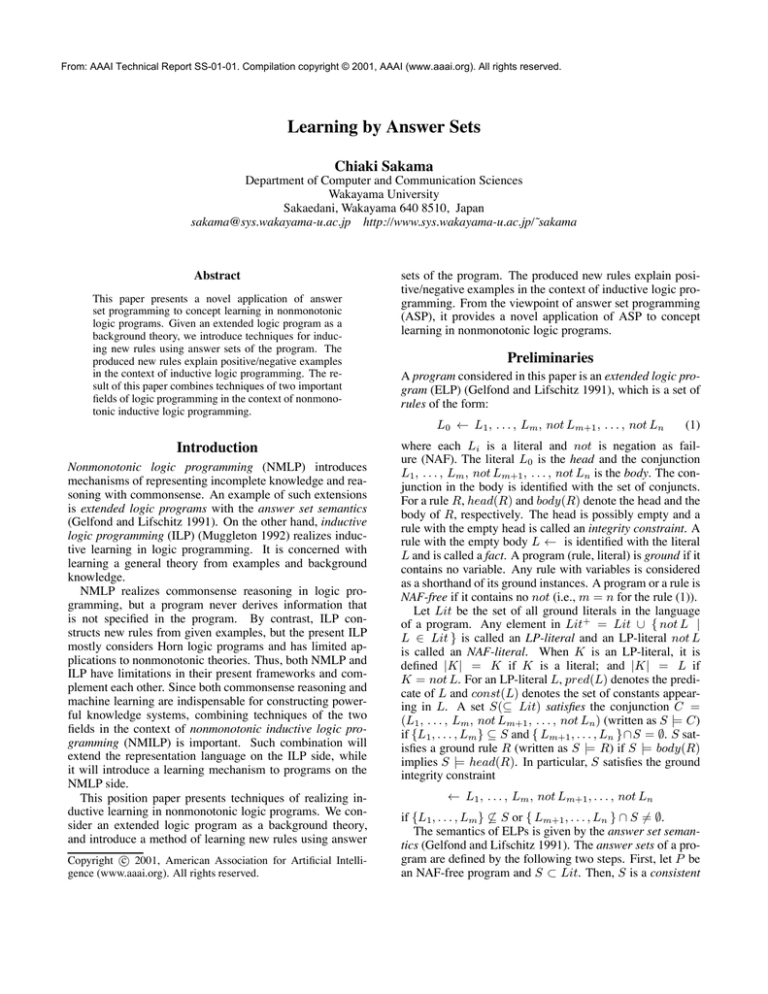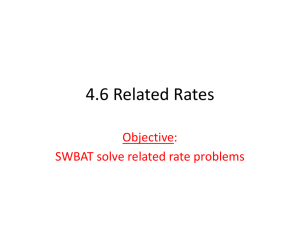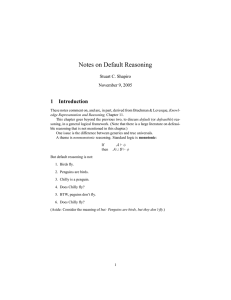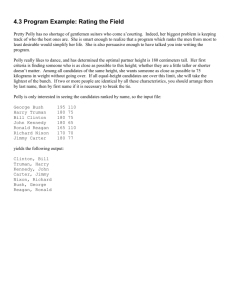
From: AAAI Technical Report SS-01-01. Compilation copyright © 2001, AAAI (www.aaai.org). All rights reserved.
Learning by Answer Sets
Chiaki Sakama
Department of Computer and Communication Sciences
Wakayama University
Sakaedani, Wakayama 640 8510, Japan
sakama@sys.wakayama-u.ac.jp http://www.sys.wakayama-u.ac.jp/˜sakama
Abstract
This paper presents a novel application of answer
set programming to concept learning in nonmonotonic
logic programs. Given an extended logic program as a
background theory, we introduce techniques for inducing new rules using answer sets of the program. The
produced new rules explain positive/negative examples
in the context of inductive logic programming. The result of this paper combines techniques of two important
fields of logic programming in the context of nonmonotonic inductive logic programming.
Introduction
Nonmonotonic logic programming (NMLP) introduces
mechanisms of representing incomplete knowledge and reasoning with commonsense. An example of such extensions
is extended logic programs with the answer set semantics
(Gelfond and Lifschitz 1991). On the other hand, inductive
logic programming (ILP) (Muggleton 1992) realizes inductive learning in logic programming. It is concerned with
learning a general theory from examples and background
knowledge.
NMLP realizes commonsense reasoning in logic programming, but a program never derives information that
is not specified in the program. By contrast, ILP constructs new rules from given examples, but the present ILP
mostly considers Horn logic programs and has limited applications to nonmonotonic theories. Thus, both NMLP and
ILP have limitations in their present frameworks and complement each other. Since both commonsense reasoning and
machine learning are indispensable for constructing powerful knowledge systems, combining techniques of the two
fields in the context of nonmonotonic inductive logic programming (NMILP) is important. Such combination will
extend the representation language on the ILP side, while
it will introduce a learning mechanism to programs on the
NMLP side.
This position paper presents techniques of realizing inductive learning in nonmonotonic logic programs. We consider an extended logic program as a background theory,
and introduce a method of learning new rules using answer
c 2001, American Association for Artificial IntelliCopyright gence (www.aaai.org). All rights reserved.
sets of the program. The produced new rules explain positive/negative examples in the context of inductive logic programming. From the viewpoint of answer set programming
(ASP), it provides a novel application of ASP to concept
learning in nonmonotonic logic programs.
Preliminaries
A program considered in this paper is an extended logic program (ELP) (Gelfond and Lifschitz 1991), which is a set of
rules of the form:
L0 ← L1 , . . . , Lm , not Lm+1 , . . . , not Ln
(1)
where each Li is a literal and not is negation as failure (NAF). The literal L0 is the head and the conjunction
L1 , . . . , Lm , not Lm+1 , . . . , not Ln is the body. The conjunction in the body is identified with the set of conjuncts.
For a rule R, head(R) and body(R) denote the head and the
body of R, respectively. The head is possibly empty and a
rule with the empty head is called an integrity constraint. A
rule with the empty body L ← is identified with the literal
L and is called a fact. A program (rule, literal) is ground if it
contains no variable. Any rule with variables is considered
as a shorthand of its ground instances. A program or a rule is
NAF-free if it contains no not (i.e., m = n for the rule (1)).
Let Lit be the set of all ground literals in the language
of a program. Any element in Lit+ = Lit ∪ { not L |
L ∈ Lit } is called an LP-literal and an LP-literal not L
is called an NAF-literal. When K is an LP-literal, it is
defined |K| = K if K is a literal; and |K| = L if
K = not L. For an LP-literal L, pred(L) denotes the predicate of L and const(L) denotes the set of constants appearing in L. A set S(⊆ Lit) satisfies the conjunction C =
(L1 , . . . , Lm , not Lm+1 , . . . , not Ln ) (written as S |= C)
if {L1 , . . . , Lm } ⊆ S and { Lm+1 , . . . , Ln }∩S = ∅. S satisfies a ground rule R (written as S |= R) if S |= body(R)
implies S |= head(R). In particular, S satisfies the ground
integrity constraint
← L1 , . . . , Lm , not Lm+1 , . . . , not Ln
if {L1 , . . . , Lm } ⊆ S or { Lm+1 , . . . , Ln } ∩ S = ∅.
The semantics of ELPs is given by the answer set semantics (Gelfond and Lifschitz 1991). The answer sets of a program are defined by the following two steps. First, let P be
an NAF-free program and S ⊂ Lit. Then, S is a consistent
answer set of P if S is a minimal set which satisfies every
ground rule from P and does not contain both L and ¬L for
any L ∈ Lit. Next, let P be any program and S ⊂ Lit.
Then, define the NAF-free program P S as follows: a rule
L0 ← L1 , . . . , Lm is in P S iff there is a ground rule of
the form (1) from P such that { Lm+1 , . . . , Ln } ∩ S = ∅.
Then, S is a consistent answer set of P if S is a consistent
answer set of P S . A consistent answer set is simply called
an answer set hereafter. For an answer set S, we define
S + = S ∪ { not L | L ∈ Lit \ S }.
A program P is consistent if it has a (consistent) answer
set; otherwise P is inconsistent. Throughout the paper, a
program is assumed to be consistent unless stated otherwise.
A program P is called categorical if it has a unique consistent answer set (Baral and Gelfond 1994). If a rule R (resp.
a conjunction C) is satisfied in every answer set of P , it is
written as P |= R (resp. P |= C); otherwise P |= R (resp.
P |= C). In particular, P |= L if a literal L is included in
every answer set of P ; otherwise P |= L.
Learning from Positive Examples
A typical induction problem is as follows. Given a background program P and a ground literal L which represents
a (positive) example, construct a rule R satisfying
P ∪ {R} |= L
(2)
and P ∪ {R} is consistent. Here, it is assumed that
P |= L ,
(3)
since if P |= L there is no need to introduce R. We also
assume that P , R, and L have the same language.
The problem is how to compute R efficiently. We first
present a couple of propositions which are used later.
Proposition 1 Let P be a program, R a rule, and L a
ground literal. Suppose that P ∪ {R} is consistent and
P ∪ {R} |= L. If P |= R, then P |= L.
Proof: Suppose that P |= R and P |= L. Then,
there is an answer set S of P such that L ∈ S. By
P |= R, S |= R. If { L1 , . . . , Lm } ⊆ S or
{ Lm+1 , . . . , Ln } ∩ S = ∅ for any ground instance R :
L0 ← L1 , . . . , Lm , not Lm+1 , . . . , not Ln of R, then S
does not satisfy the bodies of those instances. Then S is an
answer set of P S ∪ {R}S , hence an answer set of P ∪ {R}.
As L ∈ S, this contradicts the assumption P ∪ {R} |= L.
Else if { L1 , . . . , Lm } ⊆ S and { Lm+1 , . . . , Ln } ∩ S = ∅
for some ground instance R of R, L0 ← L1 , . . . , Lm is
in {R}S . By S |= R, L0 ∈ S. So S is an answer set of
P S ∪ {R}S , thereby an answer set of P ∪ {R}. Again, this
contradicts the assumption P ∪ {R} |= L.
Proposition 2 Let P be a program and L a ground literal
such that pred(L) does not appear in P . If there is a rule
R such that P ∪ {R} is consistent and there is a ground
instance Rθ of R with some substitution θ such that P ∪
{ Rθ } |= L, then P ∪ {R} |= L.
Proof: Let R = α(x) ← Γ(x) and Rθ = α(t) ← Γ(t),
where θ = { x/t }, α(x) is either p(x) or ¬p(x) for some
predicate p and Γ(x) is a conjunction of LP-literals. Since P
does not contain the predicate of L, P ∪ { Rθ } |= L implies
L = α(t). On the other hand, P ∪ { α(t) ← Γ(t) } |= α(t)
implies P |= Γ(t). Suppose that P ∪ {R} |= Γ(t). Then,
there is an answer set S of P ∪ {R} such that S |= Γ(t).
As P ∪ { Rθ } |= Γ(t), an introduction of some instance of
R makes Γ(t) unsatisfied. Let α(s) ← Γ(s) be a ground
instance of R such that S |= Γ(s), S |= α(s), and Γ(t) contains not α(s). Then, Γ(s) also contains not α(s), and the
introduction of α(s) ← Γ(s) makes P ∪ {R} inconsistent.
This contradicts the assumption that P ∪ {R} is consistent.
By Proposition 1, P ∪ {R} |= L and P |= L imply
P |= R.
(4)
The relation (4) is a necessary condition for the induction
problem satisfying (2) and (3). By Proposition 2, on the
other hand, if an example L has a predicate which does
not appear in P and there is a rule R such that P ∪ {R}
is consistent, then finding a ground instance Rθ such that
P ∪{ Rθ } |= L leads to the construction of R satisfying (2).
This is a sufficient condition for R.
In Proposition 2, if the predicate of L appears in P , the
result does not hold in general.
Example 1 Consider the program P and the example L
such that
P :
L:
q(a) ← p(b).
p(a).
Then, for the rule R = p(x) ← not q(x) and the substitution
θ = { x/a }, P ∪ { Rθ } |= L holds. But P ∪ { R } |= L
because P ∪ { R } has the answer set { p(b), q(a) }.
In many induction problems an example L is a newly observed evidence such that the background program P contains no information on pred(L). When P contains a rule
with pred(L) in its head, the problem of computing hypotheses satisfying (2) is usually solved using abduction.
On the other hand, the condition of Proposition 2 is relaxed
when a program P and a rule R are NAF-free.
Proposition 3 Let P be an NAF-free program and L a
ground literal. If there is an NAF-free rule R such that
P ∪ {R} is consistent and there is a ground instance Rθ
of R with some substitution θ such that P ∪ { Rθ } |= L,
then P ∪ {R} |= L.
Proof: A consistent NAF-free program has a single answer
set. Suppose that P1 and P2 are consistent NAF-free programs which have the answer sets S1 and S2 , respectively.
Then, P1 ⊆ P2 implies S1 ⊆ S2 . Since P ∪ {R} is consistent and P ∪{ Rθ } ⊆ P ∪{ R }, the answer set of P ∪{ Rθ }
is a subset of the answer set of P ∪ { R }. Hence, the result
holds.
Proposition 3 is useful for ILP problems containing no
NAF.
We use these necessary and sufficient conditions to construct rules in induction problems. To simplify the problem,
in what follows we consider a program P which is functionfree and categorical. Given two ground LP-literals L1 and
L2 , we define the relation L1 ∼ L2 if pred(L1 ) = pred(L2 )
and const(L1 ) = const(L2 ). Let L1 and L2 be two ground
LP-literals such that each literal has a predicate of arity ≥ 1.
Then, L1 in a ground rule R is relevant to L2 if either (i)
L1 ∼ L2 or (ii) L1 shares a constant with an LP-literal L3
in R such that L3 is relevant to L2 . On the other hand, given
a program P and an example L, a ground LP-literal K is
involved in P ∪ {L} if |K| appears in the ground instance of
P ∪ {L}.
Suppose that a program P has the unique answer set S.
By (4) the following relation holds.
S |= R.
(5)
Then, we start to find a rule R satisfying the condition (5).
Consider the integrity constraint ← Γ where Γ consists of
ground LP-literals in S + such that every element in Γ is relevant to the example L, and is also involved in P ∪ {L}.
Since S does not satisfy this integrity constraint,
S |= ← Γ
(6)
holds. That is, ← Γ is a rule which satisfies the condition (5).
Next, it holds that P |= L for the example L by (3). Then,
S |= L, so not L is in S + . Since not L is relevant to L, the
integrity constraint ← Γ contains not L in its body. We shift
the literal L to the head and produce
L←Γ
(7)
where Γ = Γ \ {not L}.
Finally, we generalize the rule (7) by constructing a rule
R∗ such that R∗ θ = L ← Γ for some substitution θ.
The next theorem presents that the rule R∗ satisfies the
condition (4).
Theorem 4 Let P be a categorical program and R∗ a rule
obtained as above. Then, P |= R∗ .
Proof: Suppose a rule L ← Γ of (7). As Γ ⊆ S + and
L ∈ S, S |= L ← Γ . Thus, S does not satisfy a ground
instance (7) of R∗ . Hence S |= R∗ , thereby P |= R∗ .
The next theorem presents a sufficient condition of R∗ to
satisfy the relation (2).
Theorem 5 Let P be a categorical program, L a ground literal, and R∗ a rule obtained as above. If P ∪{R∗ } is consistent and pred(L) does not appear in P , then P ∪{R∗ } |= L.
Proof: Let R∗ θ = L ← Γ be the rule of (7). As P ∪ {R∗ }
is consistent, P ∪ { R∗ θ } is consistent. For the answer set
S of P , S |= Γ . Since pred(L) does not appear in P ,
S ∪ { L } becomes the answer set of P ∪ { R∗ θ }. Hence,
P ∪ { R∗ θ } |= L, and the result holds by Proposition 2. When P ∪ {R∗ } is inconsistent, construct a rule R∗∗ by
dropping some LP-literals from the body of {R∗ }. If P ∪
{R∗∗ } is consistent and pred(L) does not appear in P , P ∪
{R∗∗ } |= L holds by Theorem 5.
Example 2 Let P be the program
bird(x) ← penguin(x),
bird(tweety) ←,
penguin(polly) ← .
Given the example L = f lies(tweety), it holds that P |=
f lies(tweety). Our goal is then to construct a rule R satisfying P ∪ {R} |= L.
First, the set S + of LP-literals becomes
S + = { bird(tweety), bird(polly), penguin(polly),
not penguin(tweety), not f lies(tweety),
not f lies(polly), not ¬bird(tweety),
not ¬bird(polly), not ¬penguin(polly),
not ¬penguin(tweety), not ¬f lies(tweety),
not ¬f lies(polly) }.
From S + picking up LP-literals which are relevant to L and
are involved in P ∪ {L}, the integrity constraint:
← bird(tweety), not penguin(tweety), not f lies(tweety)
is constructed. Next, shifting f lies(tweety) to the head produces
f lies(tweety) ← bird(tweety), not penguin(tweety) .
Finally, replacing tweety by a variable x, the rule
R∗ : f lies(x) ← bird(x), not penguin(x)
is obtained, where P ∪ {R∗ } |= L holds.
Learning from Negative Examples
In induction problems, negative examples are considered as
well as positive ones. In contrast to positive examples, negative examples are facts that should not be entailed. For negative examples, an induction problem is stated as follows.
Given a program P and a ground literal L which represents
a negative example, construct a rule R satisfying
P ∪ {R} |= L
(8)
and P ∪ {R} is consistent. Here, it is assumed that
P |= L ,
(9)
since if P |= L there is no need to introduce R.
As the case of positive examples, we first introduce necessary and sufficient conditions for computing R.
Proposition 6 Let P be a program, R a rule, and L a
ground literal. Suppose that P ∪ {R} is consistent and
P ∪ {R} |= L. If P |= R, then P |= L.
Proof: Similar to the proof of Proposition 1.
The dependency graph of a program P is a directed graph
such that nodes are predicates in P and there is a positive
edge (resp. negative edge) from p1 to p2 if there is a rule R in
P such that head(R) contains the predicate p1 and body(R)
contains a literal L (resp. not L) such that pred(L) = p2 .
We say that p1 depends on p2 (in P ) if there is a path from
p1 to p2 . On the other hand, p1 strongly depends on p2 if for
every path containing a node p1 , p1 depends on p2 . Also, p1
negatively depends on p2 if any path from p1 to p2 contains
an odd number of negative edges.
Proposition 7 Let P be a program and L a ground literal.
Suppose that there is a rule R such that P ∪{R} is consistent
and there is a ground instance Rθ of R with some substitution θ such that P ∪ { Rθ } |= L. If pred(L) strongly and
negatively depends on the predicate of head(Rθ) in P , then
P ∪ {R} |= L.
Proof: By P ∪{ Rθ } |= L, L is not included in some answer
set of P ∪ { Rθ }. Since pred(L) strongly and negatively
depends on the predicate of head(R) in P , the introduction
of an instance Rη to P ∪ { Rθ } for any substitution η does
not make L true in any answer set of P ∪ {R}. Hence,
P ∪ {R} |= L holds.
Example 3 Consider the program P and the negative example L such that
P :
L:
p(x) ← q(x), not r(x),
q(a) ←,
s(a) ← .
p(a).
Since p strongly and negatively depends on r in P , P ∪
{ r(a) ← s(a) } |= L implies P ∪ { r(x) ← s(x) } |= L.
By Proposition 6 the relation
P |= R
becomes a necessary condition for the problem satisfying (8)
and (9). Then, we construct a hypothetical rule in a similar
manner to the case of positive examples. We again assume
function-free and categorical programs hereafter.
Suppose that a program P has the unique answer set S.
Then, the relation
S |= R
holds. The integrity constraint ← Γ is constructed for Γ ⊆
S + of ground LP-literals which are relevant to the negative
example L and are involved in P ∪ {L}. Then, the relation
S |= ← Γ
holds. On the other hand, to construct an objective rule from
the integrity constraint ← Γ, we shift a literal which has a
target predicate. Here, a target predicate is a pre-specified
predicate which is subject to learn. In case of positive examples, we identified the target predicate with the one appearing in the positive example. This is because the purpose of
learning from positive examples is to construct a new rule
which entails the positive example. In case of negative examples, on the other hand, the negative example L is already
entailed from the program P (P |= L). The purpose is then
to block the entailment of L by introducing some rule R to
P . In this situation, the rule R does not have the predicate of
L in its head in general. So we distinguish the target predicate from the one appearing in L. We select a target predicate from predicates in P on which pred(L) strongly and
negatively depends. Thus, if Γ contains an LP-literal not K
which contains the target predicate satisfying this condition,
we construct
K ← Γ
(10)
from ← Γ where Γ = Γ \ { not K }. Note that Γ may
contain no not K with the target predicate. On the other
hand, if the target predicate occurs in more than one NAFliteral in Γ, the rule (10) is constructed by shifting one of
these literals. As a result, there are none, one, or several
rules of the form (10) which are constructed from ← Γ.
Finally, we generalize the rule (10) to R∗ such that R∗ θ =
K ← Γ by replacing constants with appropriate variables.
Then the following result holds.
Theorem 8 Let P be a categorical program and R∗ a rule
obtained as above. Then, P |= R∗ .
Proof: Similar to the proof of Theorem 4.
By contrast, whether the relation P ∪ {R∗ } |= L holds or
not depends on the existence of an appropriate target predicate.
Theorem 9 Let P be a categorical program, L a ground
literal, and R∗ a rule obtained as above. If P ∪ {R∗ } is
consistent and P ∪ { R∗ θ } |= L for some substitution θ,
then P ∪ {R∗ } |= L.
Proof: Since pred(L) strongly and negatively depends on
the predicate of R∗ in P , the result holds by Proposition 7.
Example 4 Let P be the program
f lies(x) ← bird(x), not ab(x),
bird(x) ← penguin(x),
bird(tweety) ←,
penguin(polly) ← .
Given the negative example L = f lies(polly), it holds that
P |= f lies(polly). Our goal is then to construct a rule R
satisfying P ∪ {R} |= L.
First, the set S + of LP-literals becomes
S + = { bird(tweety), bird(polly), penguin(polly),
not penguin(tweety), f lies(tweety),
f lies(polly), not ab(tweety), not ab(polly),
not ¬bird(tweety), not ¬bird(polly),
not ¬penguin(polly), not ¬penguin(tweety),
not ¬f lies(tweety), not ¬f lies(polly),
not ¬ab(tweety), not ¬ab(polly) }.
From S + picking up LP-literals which are relevant to L and
are involved in P ∪ {L}, the following integrity constraint is
constructed:
← bird(polly), penguin(polly), f lies(polly), not ab(polly) .
Let ab be the target predicate on which f lies strongly and
negatively depends. Then, shifting ab(polly) to the head, it
becomes
ab(polly) ← bird(polly), penguin(polly), f lies(polly) .
Replacing polly by a variable x, we get
R∗ : ab(x) ← bird(x), penguin(x), f lies(x) .
In this case, however, P ∪ {R∗ } is inconsistent.
To get a consistent program, dropping f lies(x) from R∗ ,
we get
R∗∗ : ab(x) ← bird(x), penguin(x)
where P ∪ {R∗∗ } | = L holds. The rule R∗∗ is further simplified as
ab(x) ← penguin(x)
using the second rule in P .
Discussion
Learning from Multiple Examples
Our algorithm is also applicable to learning from a set of examples by iteratively applying the procedure to each example. For instance, suppose that the set of positive examples
E = { f lies(tweety), ¬f lies(polly) } is given to the program P of Example 2. Then, applying the algorithm to each
example, the rule
R1∗ = f lies(x) ← bird(x), not penguin(x)
is induced by the example f lies(tweety), and the rule
R2∗
= ¬f lies(x) ← bird(x), penguin(x)
is induced by the example ¬f lies(polly). As a result,
P ∪ { R1∗ , R2∗ } |= e for every e ∈ E. This is also the
case for a set of negative examples. When sets of positive
and negative examples are given to a program P , firstly induce rules by positive examples and incorporate them into
P . In the resulting program P , subsequently induce rules
by negative examples. Note that when examples are successively given, the result of induction depends on the order of examples in general. For instance, given the program P = { bird(tweety) } and the positive example E1 =
{ has wing(tweety) }, the rule
R1∗ = has wing(x) ← bird(x)
is induced. Next, from the program P ∪ {R1∗ } and the the
positive example E2 = { f lies(tweety) }, the rule
answer set. For instance, consider the program P and the
positive example L such that
P :
p(a) ← not q(a),
q(a) ← not p(a).
r(a).
L:
Here, P has two answer sets S1 = {p(a)} and S2 = {q(a)}.
Then, applying the algorithm to each answer set, the rule
R1∗ = r(x) ← p(x), not q(x)
is induced using S1 , while the rule
R2∗ = r(x) ← q(x), not p(x)
is induced using S2 . Consequently, P ∪{ R1∗ , R2∗ } |= L. For
non-categorical programs Theorems 4 and 8 hold, and the
sufficient conditions of Theorems 5 and 9 are also extended
in a straightforward manner. A formal theory of induction
in programs having multiple answer sets will be discussed
in the full version of this paper.
Correctness and Completeness
An induction algorithm is correct with respect to a positive
example (resp. a negative example) L if a rule R produced
by the algorithm satisfies P ∪{R} |= L (resp. P ∪{R} |= L).
We provided sufficient conditions to guarantee the correctness of the proposed algorithm with respect to positive examples (Theorem 5) and negative examples (Theorem 9).
On the other hand, an induction algorithm is complete
with respect to a positive example (resp. a negative example)
L if it produces every rule R satisfying P ∪ {R} |= L (resp.
P ∪ {R} |= L). The proposed algorithm is incomplete with
respect to both positive and negative examples. For instance,
in Example 2 the rule f lies(tweety) ← bird(polly) explains f lies(tweety) in P , while this rule is not constructed
by the procedure. Generally, there exist possibly infinite solutions for explaining an example. For instance, consider the
program P and the positive example L such that
P :
r(f (x)) ← r(x),
q(a) ←,
r(b) ← .
p(a).
R2∗ = f lies(x) ← bird(x), has wing(x)
is induced. By contrast, from P and E2 the rule
R3∗ = f lies(x) ← bird(x)
is induced, and from P ∪ {R3∗ } and E1 the rule
R4∗ = has wing(x) ← bird(x), f lies(x)
is induced. Thus, in incremental learning the order of examples taken into consideration affects the program to be
induced in general.
Learning from Non-Categorical Programs
In this paper we considered induction in categorical programs. The proposed algorithm is also extensible to programs having multiple answer sets. When a program has
more than one answer set, different rules are induced by each
L:
Then, the following rules
p(x) ← q(x),
p(x) ← q(x), r(b),
p(x) ← q(x), r(f (b)),
···
all explain p(a). However, every rule except the first one
seems meaningless. In the presence of NAF, useless hypotheses
p(x) ← q(x), not q(b),
p(x) ← q(x), not r(a),
···
are also constructed by attaching arbitrary NAF-literal not L
such that P |= L to the body of the rule. These examples show that the completeness of an induction algorithm
is of little value in practice because there are tons of useless hypotheses in general. What is important is selecting
meaningful hypotheses in the process of induction, and this
is realized in our algorithm by filtering out irrelevant or disinvolved literals in S + to construct ← Γ.
Computability
We considered an ELP which is function-free and has exactly one consistent answer set. With the function-free setting, S + is finite and selection of relevant and involved literals from S + is done in polynomial-time. An important
class of categorical programs is stratified programs. When
a stratified program is function-free, the perfect model (or
equivalently, the answer set) S is constructed in time linear
in the size of the program (Schlipf 1995). In this case, an
inductive hypothesis R∗ is efficiently constructed from S + .
Connection to Answer Set Programming
Answer set programming (ASP) is a new paradigm of logic
programming which attracts much attention recently (Marek
and Truszczyński 1999; Niemelä 1999). In the presence of
negation as failure in a program, a logic program has multiple intended models in general rather than the single least
Herbrand model in a Horn logic program. ASP views a program as a set of constraints which every solution should satisfy, then extracts solutions from the collection of answer
sets of the program. We constructed inductive hypotheses
from answer sets. In this setting, a background theory and
examples work as constraints which inductive hypotheses
should satisfy, and induction in nonmonotonic logic programs is realized by computing answer sets of a program.
Thus, induction problems in nonmonotonic logic programs
are captured as a problem of ASP. The result also implies
that existing proof procedures for answer set programming
are used for computing hypotheses in nonmonotonic ILP.
Answer sets are used for computing hypotheses in logic
programming. For instance, in abduction hypothetical facts
which explain an observation are computed using the answer
sets of an abductive logic program (Kakas and Mancarella
1990; Inoue and Sakama 1996; Sakama and Inoue 1999). By
contrast, in induction hypothetical rules which explain positive/negative examples are constructed from a background
theory and examples. We showed that such rules are automatically constructed using answer sets of a program. The
result indicates that answer sets are useful for computing induction as well as abduction, and it enhances commonsense
reasoning in logic programming.
Related Work
There are some ILP systems which perform induction in
nonmonotonic logic programs. In (Bain and Muggleton
1992; Inoue and Kudoh 1997) a monotonic rule satisfying positive examples is firstly produced and subsequently
specialized by incorporating NAF literals to the rule. (Dimopoulos and Kakas 1995) constructs default rules without
NAF in a hierarchical structure. In (Bergadano et al 1996)
the hypotheses space are prepared in advance. (Martin and
Vrain 1996) considers learning normal logic programs under the 3-valued semantics. (Seitzer 1997) first computes
stable models of the background program, then induces hypotheses using an ordinary ILP algorithms. Our algorithm
is essentially different from these work on the point that we
construct nonmonotonic rules directly from the background
program using answer sets. (Muggleton 1998) constructs a
hypothetical clause using the enlarged bottom set which is
the least Herbrand model augmented by closed world negation. Our algorithm is close to him, but he considers Horn
logic programs and induced rules do not contain NAF. The
results in this paper are also formulated in a different manner
by (Sakama 2000) using the inverse entailment in nonmonotonic logic programs.
Summary
This paper studied inductive learning in nonmonotonic logic
programs. We provided algorithms for constructing new
rules in the face of positive and negative examples, and
showed how answer sets can be used to induce definitions
of concepts in nonmonotonic logic programs. The results of
this paper combines techniques of the two important fields
of logic programming, NMLP and ILP, and contributes to a
theory of nonmonotonic inductive logic programming.
The proposed algorithms are applicable to an important
class of nonmonotonic logic programs including stratified
programs. Future research includes extending the algorithms to a wider class of programs, and exploiting further
connection between NMLP and ILP.
References
M. Bain and S. Muggleton. Non-monotonic learning. In: S.
Muggleton (ed.), Inductive Logic Programming, Academic
Press, pp. 145–161, 1992.
C. Baral and M. Gelfond. Logic programming and
knowledge representation. Journal of Logic Programming
19/20:73–148, 1994.
F. Bergadano, D. Gunetti, M. Nicosia, and G. Ruffo. Learning logic programs with negation as failure. In: L. De
Raedt (ed.), Advances in Inductive Logic Programming,
IOS Press, pp. 107–123, 1996.
Y. Dimopoulos and A. Kakas. Learning nonmonotonic
logic programs: learning exceptions. In: Proceedings of
the 8th European Conference on Machine Learning, Lecture Notes in Artificial Intelligence 912, Springer-Verlag,
pp. 122–137, 1995.
M. Gelfond and V. Lifschitz. Classical negation in logic
programs and disjunctive databases. New Generation Computing 9:365–385, 1991.
K. Inoue and C. Sakama. A fixpoint characterization of
abductive logic programs. Journal of Logic Programming
27(2):107–136, 1996.
K. Inoue and Y. Kudoh. Learning extended logic programs.
In: Proceedings of the 15th International Joint Conference
on Artificial Intelligence, Morgan Kaufmann, pp. 176–181,
1997.
A. C. Kakas and P. Mancarella. Generalized stable models: a semantics for abduction. In: Proceedings of the
9th European Conference on Artificial Intelligence, Pitman, pp. 385–391, 1990.
V. W. Marek and M. Truszczyński. Stable models and an
alternative logic programming paradigm. In: K. R. Apt
et al. (eds.), The Logic Programming Paradigm – A 25
Year Perspective, Springer-Verlag, pp. 375–398, 1999.
L. Martin and C. Vrain. A three-valued framework for the
induction of general logic programs. In: L. De Raedt (ed.),
Advances in Inductive Logic Programming, IOS Press, pp.
219–235, 1996.
S. Muggleton (ed.). Inductive Logic Programming, Academic Press, 1992.
S. Muggleton. Completing inverse entailment. In: Proceedings of the 8th International Workshop on Inductive
Logic Programming, Lecture Notes in Artificial Intelligence 1446, Springer-Verlag, pp. 245–249, 1998.
I. Niemelä. Logic programs with stable model semantics
as a constraint programming paradigm. Annals of Mathematics and Artificial Intelligence 25:241–273, 1999.
C. Sakama. Inverse entailment in nonmonotonic logic programs. In: Proceedings of the 10th International Conference on Inductive Logic Programming, Lecture Notes in
Artificial Intelligence 1866, Springer-Verlag, pp. 209–224,
2000.
C. Sakama and K. Inoue. Updating extended logic programs through abduction. In: Proceedings of the 5th International Conference Logic Programming and Nonmonotonic Reasoning, Lecture Notes in Artificial Intelligence
1730, pp. 147–161, Springer-Verlag, 1999.
J. S. Schlipf. Complexity and undecidability results for
logic programing. Annals of Mathematics and Artificial
Intelligence 15:257–288, 1995.
J. Seitzer. Stable ILP: exploring the added expressivity of
negation in the background knowledge. In: Proceedings of
IJCAI-95 Workshop on Frontiers of ILP, 1997.








